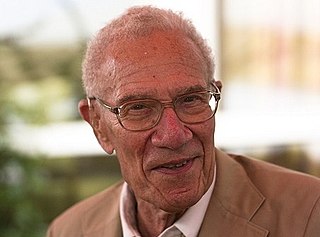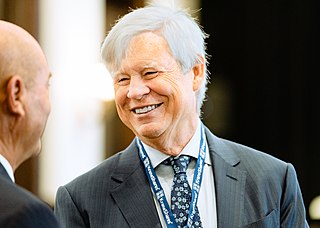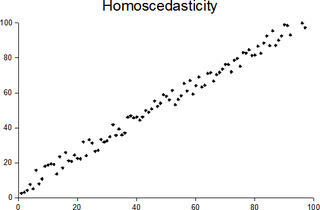Related Research Articles
Econometrics is an application of statistical methods to economic data in order to give empirical content to economic relationships. More precisely, it is "the quantitative analysis of actual economic phenomena based on the concurrent development of theory and observation, related by appropriate methods of inference". An introductory economics textbook describes econometrics as allowing economists "to sift through mountains of data to extract simple relationships". Jan Tinbergen is one of the two founding fathers of econometrics. The other, Ragnar Frisch, also coined the term in the sense in which it is used today.

Robert Merton Solow, GCIH is an American economist whose work on the theory of economic growth culminated in the exogenous growth model named after him. He is currently Emeritus Institute Professor of Economics at the Massachusetts Institute of Technology, where he has been a professor since 1949. He was awarded the John Bates Clark Medal in 1961, the Nobel Memorial Prize in Economic Sciences in 1987, and the Presidential Medal of Freedom in 2014. Four of his PhD students, George Akerlof, Joseph Stiglitz, Peter Diamond and William Nordhaus later received Nobel Memorial Prizes in Economic Sciences in their own right.
Econometrica is a peer-reviewed academic journal of economics, publishing articles in many areas of economics, especially econometrics. It is published by Wiley-Blackwell on behalf of the Econometric Society. The current editor-in-chief is Guido Imbens.

Sir Clive William John Granger was a British econometrician known for his contributions to nonlinear time series analysis. He taught in Britain, at the University of Nottingham and in the United States, at the University of California, San Diego. Granger was awarded the Nobel Memorial Prize in Economic Sciences in 2003 in recognition of the contributions that he and his co-winner, Robert F. Engle, had made to the analysis of time series data. This work fundamentally changed the way in which economists analyse financial and macroeconomic data.

Robert Fry Engle III is an American economist and statistician. He won the 2003 Nobel Memorial Prize in Economic Sciences, sharing the award with Clive Granger, "for methods of analyzing economic time series with time-varying volatility (ARCH)".
Takeshi Amemiya is an economist specializing in econometrics and the economy of ancient Greece.
The Durbin–Wu–Hausman test is a statistical hypothesis test in econometrics named after James Durbin, De-Min Wu, and Jerry A. Hausman. The test evaluates the consistency of an estimator when compared to an alternative, less efficient estimator which is already known to be consistent. It helps one evaluate if a statistical model corresponds to the data.
In economics, discrete choice models, or qualitative choice models, describe, explain, and predict choices between two or more discrete alternatives, such as entering or not entering the labor market, or choosing between modes of transport. Such choices contrast with standard consumption models in which the quantity of each good consumed is assumed to be a continuous variable. In the continuous case, calculus methods can be used to determine the optimum amount chosen, and demand can be modeled empirically using regression analysis. On the other hand, discrete choice analysis examines situations in which the potential outcomes are discrete, such that the optimum is not characterized by standard first-order conditions. Thus, instead of examining "how much" as in problems with continuous choice variables, discrete choice analysis examines "which one". However, discrete choice analysis can also be used to examine the chosen quantity when only a few distinct quantities must be chosen from, such as the number of vehicles a household chooses to own and the number of minutes of telecommunications service a customer decides to purchase. Techniques such as logistic regression and probit regression can be used for empirical analysis of discrete choice.
The Frisch Medal is an award in economics given by the Econometric Society. It is awarded every two years for empirical or theoretical applied research published in Econometrica during the previous five years. The award was named in honor of Ragnar Frisch, first co-recipient of the Nobel prize in economics and editor of Econometrica from 1933 to 1954. In the opinion of Rich Jensen, Gilbert F. Schaefer Professor of Economics and chairperson of the Department of Economics of the University of Notre Dame, "The Frisch medal is not only one of the top three prizes in the field of economics, but also the most prestigious 'best article' award in the profession". Five Frisch medal winners have also won the Nobel Prize.
The Sargan–Hansen test or Sargan's test is a statistical test used for testing over-identifying restrictions in a statistical model. It was proposed by John Denis Sargan in 1958, and several variants were derived by him in 1975. Lars Peter Hansen re-worked through the derivations and showed that it can be extended to general non-linear GMM in a time series context.

Joshua David Angrist is an Israeli-American economist and Ford Professor of Economics at the Massachusetts Institute of Technology. Angrist, together with Guido Imbens, was awarded the Nobel Memorial Prize in Economics in 2021 "for their methodological contributions to the analysis of causal relationships".
Pietro Balestra was a Swiss economist specializing in econometrics. He was born in Lugano and earned a B.A. in economics from the University of Fribourg. Balestra moved for graduate work to the University of Kansas and Stanford University. He was awarded the Ph.D. in Economics by Stanford University in 1965.
Halbert Lynn White Jr. was the Chancellor’s Associates Distinguished Professor of Economics at the University of California, San Diego, and a Fellow of the Econometric Society and the American Academy of Arts and Sciences. A native of Kansas City, Missouri, White graduated salutatorian from Southwest High School in 1968. He earned his PhD in Economics at the Massachusetts Institute of Technology in 1976, and spent his first years as an assistant professor in the University of Rochester before moving to UCSD in 1979.
Whitney Kent Newey is the Jane Berkowitz Carlton and Dennis William Carlton Professor of Economics at the Massachusetts Institute of Technology and a well-known econometrician. He is best known for developing, with Kenneth D. West, the Newey–West estimator, which robustly estimates the covariance matrix of a regression model when errors are heteroskedastic and autocorrelated.
Manuel Arellano is a Spanish economist specialising in econometrics and empirical microeconomics. Together with Stephen Bond, he developed the Arellano–Bond estimator, a widely used GMM estimator for panel data. This estimator is based on the earlier article by Arellano's PhD supervisor, John Denis Sargan, and Alok Bhargava. RePEc lists the paper about the Arellano-Bond estimator as the most cited article in economics.
Anil K. Bera is an Indian-American econometrician. He is Professor of Economics at University of Illinois at Urbana–Champaign's Department of Economics. He is most noted for his work with Carlos Jarque on the Jarque–Bera test.
Kenneth David West is the John D. MacArthur and Ragnar Frisch Professor of Economics in the Department of Economics at the University of Wisconsin. He is currently co-editor of the Journal of Money, Credit and Banking, and has previously served as co-editor of the American Economic Review. He has published widely in the fields of macroeconomics, finance, international economics and econometrics. Among his honors are the John M. Stauffer National Fellowship in Public Policy at the Hoover Institution, Alfred P. Sloan Research Fellowship, Fellow of the Econometric Society, and Abe Fellowship. He has been a research associate at the NBER since 1985.
Xiaohong Chen is a Chinese economist who currently serves as the Malcolm K. Brachman Professor of Economics at Yale University. She is a fellow of the Econometric Society and a laureate of the China Economics Prize. As one of the leading experts in econometrics, her research focuses on econometric theory, Semi/nonparametric estimation and inference methods, Sieve methods, Nonlinear time series, and Semi/nonparametric models. She was elected to the American Academy of Arts and Sciences in 2019.
Richard T. Baillie is a British–American economist and statistician who is currently the A J Pasant Professor of Economics at the Michigan State University. He is also part time professor at King's College, London, and Senior Scientific Officer for the Rimini Center for Economic Analysis in Italy, and also on the Executive Council of the Society for Nonlinear Dynamics in Econometrics (SNDE).

In statistics, a sequence of random variables is homoscedastic if all its random variables have the same finite variance; this is also known as homogeneity of variance. The complementary notion is called heteroscedasticity, also known as heterogeneity of variance. The spellings homoskedasticity and heteroskedasticity are also frequently used. Assuming a variable is homoscedastic when in reality it is heteroscedastic results in unbiased but inefficient point estimates and in biased estimates of standard errors, and may result in overestimating the goodness of fit as measured by the Pearson coefficient.
References
- ↑ Gordon, Roger Hall (1976). Essays on the causes and equitable treatment of differences in earnings and ability (Ph.D.). MIT . Retrieved 21 January 2017.
- ↑ Specification testing and estimation using a generalized method of moments
- ↑ Kling, Jeffrey Richard (1998). Identifying causal effects of public policies (Ph.D.). MIT. hdl:1721.1/10114.
- ↑ Nonparametric functional estimation with applications to financial models
- ↑ Jerry A. Hausman at the Mathematics Genealogy Project
- ↑ "Theoretical and empirical aspects of vintage capital models". British Library EThOS. Retrieved 17 May 2013.